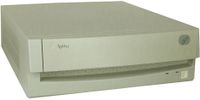Poseidon (Original)
Specifications
- IBM Aptiva 2144-A12
- Intel Pentium 233MHz (running at 166MHz due to system BIOS limitations)
- 48MB EDO DRAM
- 121MB IDE disk drive
- 4X Mitsumi CD-ROM drive
- Trident TGUI-9680 video chipset w/1MB VRAM
- Adaptec AHA-1542 SCSI host adapter
- Iomega ZIP-100 external SCSI drive
- Archive 11250-NP external parallel QIC80 tape backup (DC2120)
- IBM mWave DSP sound card/28.8kbps modem
- IBM OS/2 Warp Connect V3
- Intel EtherExpress 16 Ethernet Adapter
Original Purchase
This machine was purchased from Radio Shack in 1996. The salesman, Dominic, convinced my dad and me to buy two identical machines, configured with 8MB of RAM, a 1GB HDD, and Windows 95 preloaded. Dominic, the salesman, now works at Best Buy.
HDD Upgrade
A 2GB Maxtor hard drive, purchased from Sams Club on Mesa St. in El Paso, TX, was added to the machine at one point. Slackware was loaded on this hard drive with the assistance of Larry Landis.
OS/2 Warp v3 Installation
OS/2 Warp v3 was installed in dual-boot mode on top of Windows 95. In this configuration, the machine had a very strange boot-up arrangement:
- The OS/2 Boot Manager would come up first
- You could select from OS/2 and Win95 (depending on the current OS/2 dual-boot configuration), or Linux
- If Linux was selected, the LILO boot loader would then appear
Windows 98 Upgrade
The Windows 95 preload (still in dual-boot mode with OS/2 Warp v3) was upgraded to Windows 98. The rest of the multiboot configuration remained intact.
Usage At Home
I used IBM Works, an OS/2-native productivity software bundle included in the OS/2 Warp v3 Bonus Pak, to write all my school papers at MVCS. Internet access came by way of the InJoy Internet Dialer, as the IBM dialer for non-IBM ISPs only supported SLIP (no Van Jacobsen CSLIP or PPP), and my ISP (NMSU-Net) required an interactive (terminal-based) component in order to launch either a SLIP or PPP connection, which the IBM dialer also did not support. InJoy was a shareware product downloaded from the Hobbes OS/2 Archive, and provided full SLIP/CSLIP/PPP and interactive login support, among many other features.
Netscape Navigator 2.02 was my web browser of choice under OS/2. It came in a PKZip archive named N32E202.ZIP, the floppy disk for which I still have.
At one time, James Lines used Netscape on OS/2 on this machine after a youth group meeting to check his e-mail.
I had a series of XCOPY scripts that would back up source code and documents to the ZIP drive. I still have these ZIP disks, and their contents are archived.
Upgrade to Windows NT Workstation 4.0
At some point, I reworked the system to have Windows NT Workstation 4.0. I do not recall if I employed a multiboot scenario in this setup, but I doubt it.
Usage After Home
After moving in with Joel Martinez at his parents' home, this machine had WinRoute Lite (and later WinRoute Pro) installed under WinNT 4 in order to share its dialup Internet connection, after we ran Ethernet cabling throughout the house. During this time, the modem in use was a USRobotics 56K modem that was ultimately fried in an electrical storm.
It was during this time that Joel and I decided on the naming scheme of Greek mythological figures, and the machine was renamed from picasso to poseidon.
In 2000, it was supplanted by zeus, my Power Mac G4, in its role as personal workstation, but continued for some time to function as an Internet router.
Martinez Era
Joel Martinez used this machine as an mp3 player running OS/2 Warp v4 for a period of time. During this era, the machine's power supply failed dramatically, shooting flames out the back of the machine. A new power supply was ordered at great expense from IBM's labyrinthine website, and it was restored to working order.
During this period, a 233MHz Pentium CPU was installed in the machine, which came from Dr. Martinez' old PC. The system recognized it as a 166MHz CPU, presumably also clocking it accordingly. I believe this may have contributed to the system's subsequent decline in stability.
Trailer Era
This machine sat to the left of zeus, my Power Mac G4, as an OS/2 Warp Connect v3 machine, but in this time period, it declined in reliability, to the point where it would take many attempts to achieve a successful boot.
Historical Summary
This section was taken from my old personal website, which is archived at and accessible from The VAX Pirate's Lair. As such, the contents are likely out of date and not particularly reliable.
This computer was my main machine for a long time. I acquired it in 1996 on sale at Radio Shack. IBM had recently discontinued the series, and it came stock with 8MB RAM, a 1GB hard drive, and 0K CPU cache. Also a 133MHz Pentium processor. I had been using a 90MHz homebuilt Pentium machine with 256K cache. I learned very quickly that cache RAM can make all the difference in performance, and the P90 was faster. Unfortunately, I never got around to upgrading the cache RAM in this box, and I seriously doubt the memory is available anymore. At some point, for some long-since forgotten reason, the original CPU was replaced with a Pentium 233, which the BIOS recognizes as a Pentium 166.
Naming History
- picasso (at home)
- poseidon
